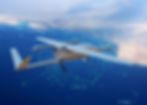The Adoption of UAVs in the Middle East
- Ewan H
- Nov 5, 2020
- 3 min read
Increasingly drones are being integrated into our daily lives and in the Middle East, it is no exception. Businesses and governments are not only working with innovators in the US, Asia and Europe but are investing in locally designed and produced drone solutions to ensure a reliable supply chain. This is due to the geopolitical tensions in the region as indicated by the dominance of unmanned combat aerial vehicles (UCAVs) in the market. However, commercial applications are also highly viable due to the vast energy infrastructure of the region. In this article, we will examine several Saudi Arabian drone startups and their solutions as well as active partnerships of global players to provide a practical overview for the Kingdom and the region.


As the preeminent military power of the region, at least in finances, Saudi Arabia is perhaps the most active in developing a robust unmanned ecosystem. In 2017, it opened up a factory in partnership with China Aerospace Science and Technology Corporation (CASC) to manufacture ‘hunter-killer’ drones akin to the famous American MQ-1 Predator. The factory was part of a greater partnership with China in a vast cultural and technological exchange. Indeed, in that same year, the Kingdom’s premier science organization, King Abdulaziz City for Science and Technology (KACST) greatly expanded their indigenous drone program with the unveiling of Saqr.
Drawing on this national interest in drones, the local startup FalconViz who specializes in surveying and mapping, developed their own proprietary processes to create accurate 3D models. In one project, they were commissioned by the city of Jeddah to survey 250,000m^2 of Al-Balad in support of the city’s UNESCO World Heritage Site application. Since then, FalconViz has signed clients such as Aecom, Saudi Aramco and Dow Chemical Company, among others.


The Arabian Desert is also home to thousands of kilometers of oil pipelines connecting pumps, refineries and distribution centers of black gold. For this reason, inspection tasks are very manpower intensive and time consuming. As one of the largest drone solution providers, Japanese based Terra Drone partnered with NDT Corrosion Control Services Co. (NDTCCS) to provide inspection and testing services not just in Saudi Arabia but in other countries of the Gulf Cooperation Council (GCC).
Saudi Arabia’s involvement in the ongoing Yemen civil war however has inadvertently unmasked vulnerabilities in its defenses of these remote locations. In September 2019, drones and cruise missiles showed that low-flying small profile airborne systems can cause massive damage to important yet volatile infrastructure. To that end, the General Authority of Military Industries (GAMI) is coordinating with INTRA Defense Technologies to manufacture UCAVs to meet this new threat. INTRA’s heavy duty Karayel was developed by Turkey’s Vestel but the Asef drone is unique not only for its vertical take-off (VTOL) capabilities but also being a 100% Saudi-developed and designed aircraft. Both drones are efforts by the Kingdom to improve self-sufficiency in their armed forces.



Meanwhile, in the United Arab Emirates (UAE), the luxurious city of Dubai seems to favor more exotic applications such as falcon training and drone taxis. The city positions itself at the forefront for the adoption of drone technology with generous government sponsorships in addition to a nurturing regulatory environment. As part of their initiative to improve food security and sustainability, the UAE was among the first countries to conduct drone-planting projects in addition to integrating drone data to enhance farming techniques.
There is no doubt that the adoption of drones in the Middle East will continue to rise. Regulators and legislatures have to be aware of the growth of drone technology but it is crucially important to achieve the optimum balance between the public good and economic efficiency.
A healthy ecosystem should always be fostered for any discussion and debate to be productive. Like most nascent innovations, it is the synchronicity with other technologies and stakeholders that determines its successfulness.
If you are thinking about drones and want to know how to start, contact us today.
Drone Academy Asia




